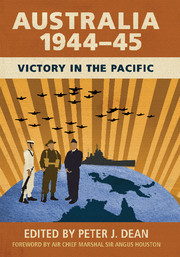Book contents
- Frontmatter
- Dedication
- Foreword
- Contents
- Maps and chart
- Figures and table
- Contributors
- Acknowledgements
- Abbreviations
- Military symbols on maps
- Introduction
- PART 1 STRATEGY
- 1 Advancing National Interests: Deciding Australia's War Strategy, 1944–45
- 2 The Southwest Pacific Area: Military Strategy and Operations, 1944–45
- 3 Holding on to the Finish: The Japanese Army in the South and Southwest Pacific, 1944–45
- PART 2 AUSTRALIA AT WAR
- PART 3 GREEN ARMOUR AND SPECIAL OPERATIONS
- PART 4 THE NAVAL AND AIR WAR
- PART 5 THE NEW GUINEA CAMPAIGN
- PART 6 THE BORNEO CAMPAIGN
- Afterword: And Then Came Peace?
- Index
- References
3 - Holding on to the Finish: The Japanese Army in the South and Southwest Pacific, 1944–45
from PART 1 - STRATEGY
Published online by Cambridge University Press: 05 December 2015
- Frontmatter
- Dedication
- Foreword
- Contents
- Maps and chart
- Figures and table
- Contributors
- Acknowledgements
- Abbreviations
- Military symbols on maps
- Introduction
- PART 1 STRATEGY
- 1 Advancing National Interests: Deciding Australia's War Strategy, 1944–45
- 2 The Southwest Pacific Area: Military Strategy and Operations, 1944–45
- 3 Holding on to the Finish: The Japanese Army in the South and Southwest Pacific, 1944–45
- PART 2 AUSTRALIA AT WAR
- PART 3 GREEN ARMOUR AND SPECIAL OPERATIONS
- PART 4 THE NAVAL AND AIR WAR
- PART 5 THE NEW GUINEA CAMPAIGN
- PART 6 THE BORNEO CAMPAIGN
- Afterword: And Then Came Peace?
- Index
- References
Summary
During the late spring and summer of 1944, the Allies penetrated the perimeter of the Japanese ‘Absolute National Defence Zone’, which was the line of defence that the Imperial Japanese Army and Navy had determined must absolutely be held for the Japanese Empire's survival. The Allies landed at Hollandia and in the Marianas, two distant parts of the perimeter. Thereafter, the Japanese continued to retreat in New Guinea and in the Central Pacific, before both axes of retreat converged in the Philippines. In 1945, the fighting moved on towards the Japanese Home Islands, but Rabaul was neutralised, while ground combat continued in New Guinea, Bougainville, Borneo, and elsewhere in the South Pacific and Southeast Asia.
This chapter reviews the Japanese Army's strategy and operations from late 1943 through the end of the war in New Guinea, the North-of-Australia (Gō-hoku; NoA) Area, Bougainville and Borneo. These were the areas of the war in which Australia's forces fought major battles during 1944–45. This overview of Japan's strategic and operational decisions will help the reader to better understand the experience of the Australian armed forces in the Pacific during the final years of the war.
The Japanese Army and Navy referred to the various regions in the Pacific Ocean with their own terms. The South Pacific Area included the Southeast Area and the NoA Area. The Southeast Area included Rabaul and the Bismarck Islands, the Solomon Islands and Eastern New Guinea – literally New Guinea east of approximately 140 degrees longitude (approximate to British New Guinea and Papua). Western New Guinea was New Guinea west of 140 degrees longitude, and the islands around the Banda Sea, including the Aru, Kai, Tanimbar, Timor and Molucca Islands, the area around the Flores Sea, the Lesser Sundas, and Celebes (approximate to Dutch New Guinea). The NoA Area included northwest New Guinea, and the areas around the Banda and Flores Seas. Western New Guinea therefore encompassed the NoA Area. The Central Pacific Area included the Caroline, Marshall, Mariana and Gilbert Islands, as well as Wake, Marcus, Nauru and Ocean Islands. Finally, the Southwest Area, which was a more loosely used term, referred to the southwest corner of the Japanese Empire at its height, and included India, Burma, Malaya, the Netherlands East Indies, Indochina and Thailand.
- Type
- Chapter
- Information
- Australia 1944–45Victory in the Pacific, pp. 51 - 76Publisher: Cambridge University PressPrint publication year: 2015



